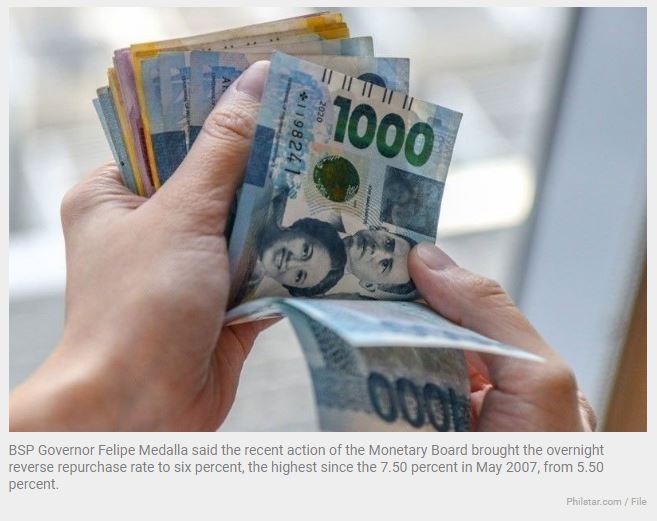Philippines: Rates hiked by 50 bps anew to tame inflation
BSP key rate hits 6%
MANILA, Philippines — The Bangko Sentral ng Pilipinas (BSP) remained hawkish as it raised key policy rates by another 50 basis points yesterday to hit its highest level in almost 16 years, a strong follow-through monetary policy response as inflation is now expected to accelerate further to above six percent this year.
BSP Governor Felipe Medalla said the recent action of the Monetary Board brought the overnight reverse repurchase rate to six percent, the highest since the 7.50 percent in May 2007, from 5.50 percent.
The overnight deposit rate was also raised to 5.50 percent from five percent, while the overnight lending was increased to 6.50 from six percent.
The hike was more aggressive than the 25-basis-point hike earlier delivered by the US Federal Reserve.
Medalla said the latest baseline inflation forecast path has shifted higher relative to the previous assessment.
“An upward adjustment in the policy interest rate would also prevent inflation expectations from drifting further away from the target band,” he said.
The Monetary Board raised its inflation forecasts to 6.1 percent from 4.5 percent for 2023 as inflation blew past expectations to a fresh 14-year high of 8.7 percent in January .
Aside from breaching the two to four percent target range, the latest inflation forecast is higher than the 5.8 percent average in 2022.
For 2024, the Monetary Board also raised its inflation forecast to 3.1 percent from 2.8 percent.
According to Medalla, the forecasts were adjusted upward following the higher-than-expected inflation outturn in January as well as the continued stronger rebound in domestic demand and gross domestic product (GDP) growth in the fourth quarter of last year.
“Both headline and core inflation measures have also continued to increase, indicating a further broadening of price pressures, particularly in services. Meanwhile, inflation expectations have likewise risen further, underscoring the need to preempt the emergence of further second-round effects,” Medalla said.
The BSP chief pointed out that the balance of risks to inflation now leans toward the upside for both 2023 and 2024, with pressures emanating from the potential impact of global food market uncertainties, continued domestic shortages in key food items, additional transport fare hikes amid elevated oil prices, and the higher-than-expected wage adjustments in 2023.
Instead of the third quarter, Medalla said monetary authorities are now expecting inflation to ease back to the two to four percent target range either in November or December this year.
Meanwhile, Medalla said the impact of a weaker-than-expected global economic recovery remains the primary downside risk to the inflation outlook.
The Monetary Board also reiterated its encouragement and support for timely and more aggressive whole-of-government actions to mitigate the impact of persistent supply-side pressures on food prices, including trade?positive measures and significant progress to boost productivity.
According to the BSP chief, the central bank stands ready to take all necessary policy action to bring inflation to within the two to four percent government target over the medium term, in line with its primary mandate of ensuring price stability.
“The Monetary Board also believes that, with domestic growth exceeding expectations in 2022, monetary action can help to dampen potential demand-side pressures and second-round effects without unduly hindering the sustained momentum of economic growth,” Medalla said.
The BSP chief said the Monetary Board is not likely to pause in its tightening cycle for the next rate-setting meeting scheduled on March 23.
He ruled out a zero or a jumbo 75-basis point hike in its next rate-setting meeting but did not rule out a pause in its monetary tightening within the first half of this year.
To tame inflation and stabilize the peso that slumped to an all-time low of 59 to $1 in October last year, the central bank raised key policy rates by 350 basis points that brought the benchmark rate to a 14-year high of 5.50 percent last year from an all-time low of two percent.
Rates From B1
For his part, BSP Deputy Governor Francisco Dakila Jr. said that the 50-basis point hike is likely to cut GDP growth of 0.04 percent.
Michael Ricafort, chief economist at Rizal Commercial Banking Corp., said the BSP has raised its key policy rates for eight straight rate-setting meetings since May last year.
Ricafort said that local policy rates would still be largely a function of the local inflation trend as well as the future Fed rate hikes after the recent signals from US Fed chair Jerome Powell on possible higher peak in Fed funds rate especially if the US labor market remains strong.
“For the coming months, local policy rates could still, at the very least, match any future Fed rate hikes after recent Fed signals and market expectations of about two to three more Fed rate hikes on the next Fed rate-setting meetings on March 22, May 3, and June 14, 2023 as well as recent signals from Fed officials on higher Fed rate peak/terminal rate in the quest to bring down elevated US inflation,” Ricafort said.
British banking giant HSBC sees the Philippines raising rates high enough to make monetary policy relatively restrictive to rein in demand.
“At the top of the list is the Philippines. We expect the BSP to raise rates to as high as 250bp above pre-pandemic levels, which should take a toll on overall borrowing and consumption,” HSBC said in its latest ASEAN Perspective titled “Will consumption hold up?”
Source: https://www.philstar.com/business/2023/02/17/2245438/rates-hiked-50-bps-anew-tame-inflation


 Thailand
Thailand




